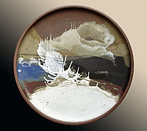
Studio S
P O T T E R Y
WELCOME!
Scroll Down For Additional Information
Master Potters from the Tennessee Conservationist
By Leila Douglas Phillips


Tennesseans can lay justifiable claim to numerous potters with enviable reputations on an international level.
Cases in point: Charles Counts, known from Beaver Ridge to Nigeria; Memphis-born Cynthia Bringle, now a producing potter at Penland School, Penland, North Carolina; Lewis Snyder of Murfreesboro, first U.S. Councilman, International Academy of Ceramics, Geneva, Switzerland; and Gatlinburg’s Douglas Ferguson of Pigeon Forge fame, who is a crafts ambassador at heart.
In 1959 Kentucky-born Counts, now of Rising Fawn, Georgia, “retired” to Beaver Ridge, adjacent to Oak Ridge where he grew up, to determine whether he could make a living by his hands.
After diligent pursuit of his art studies at Berea, Kentucky and the University of Southern Illinois as a graduate student, then further study in ceramic technology and industrial design at the University of Southern California, he turned his back on more accepted modes of living.
Later the artist and his wife, Rubynelle, a fine craftsman in her own right, moved to Rising Fawn (his pottery often bears that hallmark), to a spot of natural beauty. The Pottery Shop is a converted barn, and the family lives in a nearby farmhouse.
Each summer an intensive, eight-week school is in progress at Rising Fawn. Counts is in demand as a teacher and has been on the faculties at the University of Tennessee at Chattanooga, Arrowmont School of Crafts, Gatlinburg, and other colleges.
Formerly on the boards of the Southern Highland Handicraft Guild and the American Crafts Council, Counts is a member of the Georgia Commission for the Arts and chair-man of the liaison committee for the National Committee on Education for the Ceramic Art.
He is also author of a new how-to book, Pottery Workshop (Macmillan, 1973), and an earlier book, Common Clay, (Droke House/Hallux).
The Counts clan traveled to Nigeria to gain first-hand knowledge of the pottery tradition there. For two academic years Counts was “honorary lecturer” at Ahmadu Bello University in Zaria, Nigeria. He coordinated a national tour for Nigerian potters Ladi Kawli, and C. Mofi Athey, who traveled with the famous English craftsman, Michael Carlew, and demonstrated to “standing room only” audiences in Nashville and at the Memphis Academy of Art.
Among the American potters participating in the first International Ceramic Symposium to be held in the western hemisphere (summer of 1973), at the Memphis Academy of Art, were Cynthia Bringle and Lewis Snyder.
Snyder, Tennessee Arts Commission’s crafts programs director and organizer of the Tennessee Artist-Craftsmen Association, was director of the event which brought international artists of note together to work, to exchange ideas, and to establish better international relations.
The month-long symposium made possible a permanent Commission collection of international ceramic work now being circulated by the Tennessee State Museum.
Snyder, in addition to a B.A. from Glenville State College in Glenville, West Virginia, and an M.F.A. from Ohio University, did postgraduate work at the International Studies A-broad in Rome, Italy in 1968, where he also served on the faculty; and at the International Ceramic Symposium in Bechyne, Czechoslovakia. He belongs to the International Academy of Ceramics in Geneva, Switzerland; and his works may be viewed in the International Symposium Museum of Ceramics in Bechyne, the Museum of Decorative Arts in Prague, Czechoslovakia, and many museums and collections in this country.
Tennesseans may see fine examples of Snyder’s use of clay at Austin Peay State, East Tennessee State, Middle Tennessee State, and Vanderbilt Universities and in the traveling exhibits of the Tennessee Museum (the State Craft Collections, 1970, 1973; and the Tennessee State Sculpture Collection, 1972).

Lewis & Eric Snyder